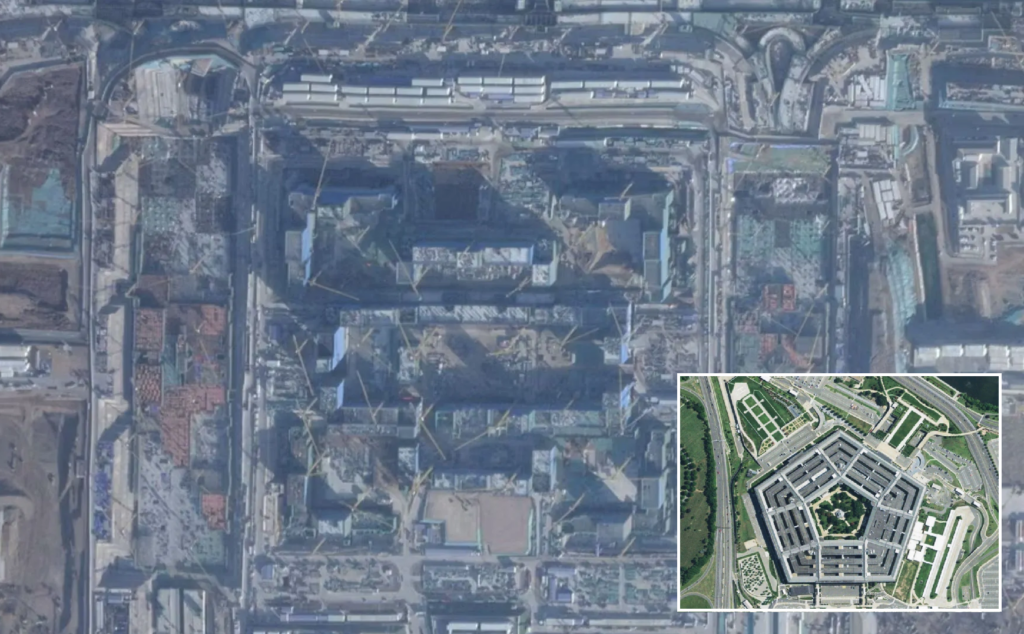
- The facility’s unprecedented scale suggests that Beijing envisions a future where military power is not solely measured by nuclear capabilities or conventional forces but also by technological supremacy in cyber and space warfare.
- China’s new military city suggests that China is not merely expanding its military capabilities in reaction to external threats but is actively shaping a new world order where U.S. hegemony is contested.
- The centralized military complex suggests that Beijing is preparing for multi-front challenges, including potential escalations along the Line of Actual Control (LAC) with India.
China has embarked on an ambitious military expansion with the construction of a massive centralized military complex in Beijing, reportedly ten times the size of the Pentagon. This new facility is designed to integrate the operations of the People’s Liberation Army (PLA), the Air Force, the Navy, the Cyber Army, and Space Warfare technology, while also fostering developments in artificial intelligence (AI) and next-generation warfare capabilities. The sheer scale and sophistication of this military hub signal China’s determination to strengthen its defence infrastructure, consolidate command structures, and enhance its ability to project power in an era of great-power competition.
A Grand Military Complex: Integrating the Future of Warfare
The construction of this sprawling military city underscores China’s strategic intent to modernize and unify its defence forces under a centralized command. The integration of cyber warfare and AI-driven technologies suggests a forward-thinking approach to future conflicts, where hybrid warfare blending traditional military might with digital, space, and economic dimensions will play a decisive role. This development aligns with the broader goals set under President Xi Jinping’s military modernization drive, which aims to transform the PLA into a world-class fighting force by 2049, the centenary of the People’s Republic of China.
The facility’s unprecedented scale suggests that Beijing envisions a future where military power is not solely measured by nuclear capabilities or conventional forces but also by technological supremacy in cyber and space warfare. China’s AI advancements, coupled with quantum computing research, are already challenging U.S. dominance in these fields, hinting at a shift in global military power dynamics.
China-US Rivalry: Strategic Significance
The unveiling of this military city will inevitably intensify tensions between China and the United States. Washington has long been wary of China’s rapid military expansion, particularly its naval buildup in the South China Sea and its advancements in missile and space warfare technology. The new facility consolidates these efforts, giving China the capacity to challenge U.S. military dominance in the Indo-Pacific.
For the U.S., China’s new military city could serve as a stark reminder of Beijing’s strategic ambitions. It suggests that China is not merely expanding its military capabilities in reaction to external threats but is actively shaping a new world order where U.S. hegemony is contested. The complex’s centralized nature also facilitates rapid mobilization, joint-force coordination, and enhanced command-and-control mechanisms critical components in potential flashpoints such as the Taiwan Strait and the South China Sea.
Implications for the China-India Border Dispute
China’s military expansion also has significant implications for its long-standing border tensions with India. The centralized military complex suggests that Beijing is preparing for multi-front challenges, including potential escalations along the Line of Actual Control (LAC) with India. Recent border clashes and infrastructure developments along the disputed Himalayan frontier indicate that China is keen on asserting its territorial claims. The military city, with its focus on AI and space warfare, could give China a significant advantage in surveillance, logistics, and rapid troop deployment along the contested border.
India, in response, has been strengthening its military posture by enhancing its border infrastructure, increasing cooperation with the U.S. and Quad partners, and bolstering Indigenous defence capabilities. However, China’s new military headquarters represents a quantum leap in strategic planning and operational readiness, potentially widening the military asymmetry between the two Asian powers.
Xi Jinping’s ‘China Dream’ and Taiwan Reunification
One of the most critical implications of China’s military expansion is its impact on Taiwan. Xi Jinping has repeatedly emphasized that Taiwan’s reunification with the mainland is a core objective of the “China Dream,” a vision of national rejuvenation. The military city consolidates China’s ability to plan, coordinate, and execute large-scale military operations, which could include a potential invasion or blockade of Taiwan.
The integration of cyber and space warfare capabilities within this complex is particularly concerning for Taiwan. A pre-emptive cyberattack disabling Taiwan’s defence systems, combined with space-based satellite disruption and AI-driven military strategies, could render traditional military responses ineffective. The U.S., which has pledged to support Taiwan’s defence, will find itself facing a China that is far better equipped for asymmetric and high-tech warfare.
Conclusion
China’s new military city is more than just a structural expansion it is a symbol of Beijing’s strategic vision, technological prowess, and geopolitical ambitions. It marks a shift in military power dynamics, challenging U.S. influence, increasing pressure on India, and setting the stage for a potential Taiwan crisis. As China continues to modernize its military under Xi Jinping’s leadership, the world must grapple with the consequences of an emerging superpower that is increasingly prepared to assert its influence, both regionally and globally.
References:
- Allen, K. (2024). China’s expanding military infrastructure: Implications for global security. The International Journal of Strategic Studies, 38(2), 45-67.
- Chan, M. (2024, January 15). China’s new military command centre raises concerns in Washington. South China Morning Post. https://www.scmp.com/news/china/military/article/China-new-military-command
- Doshi, R. (2021). The long game: China’s grand strategy to displace American order. Oxford University Press.
- Gertz, B. (2024, January 20). China’s new military city: A game-changer in the Indo-Pacific? The Washington Times. https://www.washingtontimes.com/news/china-military-expansion
- Lee, J. (2023). AI, cyber warfare, and the future of military conflicts: China’s strategic ambitions. RAND Corporation.
- Panda, A. (2024, February 1). China’s military build-up: What it means for India and Taiwan. The Diplomat. https://thediplomat.com/china-military-expansion-and-risks
- Reuters. (2024, January 28). China builds world’s largest military headquarters, integrating AI, cyber, and space forces. Reuters Defense. https://www.reuters.com/world/china-military-ai-space-command
- Sanger, D. E., & Perlez, J. (2024, February 2). Pentagon alarmed as China unveils massive new military complex. The New York Times. https://www.nytimes.com/china-military-expansion
- Singh, R. (2024, February 3). India-China border tensions: How China’s new military hub changes the equation. The Print. https://theprint.in/defense/india-china-border-tensions-military-expansion
- Xinhua News Agency. (2024, February 4). China’s defense modernization aligns with national security strategy, official says. Xinhua. https://www.xinhuanet.com/military/china-defense-strategy
Shashank is a Master’s student in Diplomacy, Law, and Business at O.P. Jindal Global University. He is also a researcher and coordinator at the Center for Global South and the Center for Southeast Asian Studies. His research interests include Southeast Asia, Chinese foreign policy, India’s Act East Policy, and global security dynamics. Views expressed are the author’s own.
